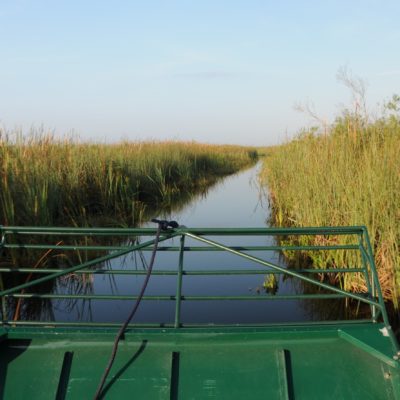Help wildlife of the Loxahatchee National Wildlife Refuge
Invasive plants have so tangled the underbrush that marsh rabbit and deer are unable enter. Rabbit are the main food for bobcats. The introduction of pythons into the Everglades is also reducing the rabbit population. Deer must stand on the narrow strip of land between wet prairie grass and woody vegetation to keep their hooves dry when water levels are moderate. When water levels are high and deer are unable to reach dry ground blocked by invasive plants, deer are prone to hoof rot disease.
The Problem
The Loxahatchee National Wildlife Refuge is suffering from too much invasive plants: Old World climbing fern (lygodium), melaleuca, and Brazilian pepperbush. Three airboats transport fifteen contractors across wet prairie grass to tree islands to cut invasive plants with machetes and spray stems with herbicide. $4 million a year is not enough to get the plants under control.
Invasive plants are harming the wildlife refuge by killing all other vegetation on the islands. If the shade does not kill plants, Old World climbing ferns keeps growing on top of plants until they collapse from the weight. Entire islands have crater-in.
The Place
The National Wildlife Refuge (one of two in Florida) was created to protect wildlife and promote public access to natural areas. Loxahatchee comes from the Seminole meaning “River of Turtles.” The Loxahatchee National Wildlife Refuge is a mosaic of wet prairies, sawgrass ridges, sloughs, tree islands, cattail communities, and a 400-acre cypress swamp. The refuge provides essential wildlife habitats for the King Rail, Limpkin, Fulvous Whistling-Duck, White and Glossy Ibis, Sandhill Crane, threatened Wood Storks, and endangered Everglade Snail Kites – home for 250 species of birds and two turtles, Peninsula Cooter and Florida Softshell.
Volunteers with Solutions
When attempts to raise more funds from state and federal agencies failed, the Ocean River Institute stepped up to design and build a better cutting device through open-source design. This will increase the contractors’ efficiency and speed to kill invasive plants. We will also train volunteers and pay refuge staff to remove cut melaleuca from the refuge.
The goals are to practice citizen science; to educate the public the challenges and rewards of sustainable stewardship of a national wildlife refuge; bring the management of invasive plants under control within the Refuge’s current budget; and partner with a commercial enterprise that will label melaleuca mulch as benefitting the Loxahatchee National Wildlife Refuge and price to include costs of removing wood from tree islands.
By picking up where state and federal government leaves off, Volunteers for the Loxahatchee are restoring a diversity of woody plants on tree islands, improving their ability to take up water, making islands once again inhabitable for deer, marsh rabbits, and bobcats, providing rookeries for birds, and ground-nesting sites for short-eared owls.

Peninsula Cooter
Please join with us and make a donation, click here.
Lox Conservation Conversation
Rolf Olson, Refuge Manager, Mark Musaus, former Refuge Manager, and Elinor Williams, president, Friends of the Arthur R. Marshall Loxahatchee National Wildlife Refuge, were Rob’s guests on Moir’s Environmental Dialogues, Ocean River Shields of Achilles.
The Loxahatchee is an awesome threshold brimming with wildlife between Lake Okeechobee, agricultural lands, and pine flatwoods to the north and the Everglades to the south, partially bounded by the largest remaining remnant of a cypress strand. An invasive plant, Old World climbing fern, is smothering about 72% of the Refuge. This tenacious vine with 100-foot-long tendrils kills plants by either blocking out light or by causing trees and other native plants to collapse under the weight. Because aerial spraying kills all plants, the climbing fern stems must be hand-cut. Then the lower portions are sprayed. Crews, brought to each island by air boat, often stand in nearly waist high water.
The Refuge is known for having the greatest number of alligators in America, not the greatest biomass of alligators, just the greatest number of snapping jaws per square foot. Snakes and insects in abundance further challenge working conditions. Climbing ferns are remarkably quick to release spores and propagate. So quick that the crew must return to the site for the next two years to fully eradicate the ferns. Five or six insects have been identified to eat Climbing ferns in their native soils. They are being researched to keep the ferns at bay provided they only chew on the invasive plant and not others.
Collaborative management with the U.S. Fish and Wildlife Service working in partnership with the South Florida Water Management District has failed to eradicate the invasive climbing fern. The federal agency spends $2 million a year, with the state spending approximately the same amount in recent years. This is woefully inadequate. Water quality and the quantity of water flowing into the Everglades are issues no less pressing than is the spread of invasive plants. There is still work to be done by concerned advocates to save the Loxahatchee.
Tune in to Moir’s Environmental Dialogues radio for wildlife and managing invasive plants in the Loxahatchee National Wildlife Refuge.







